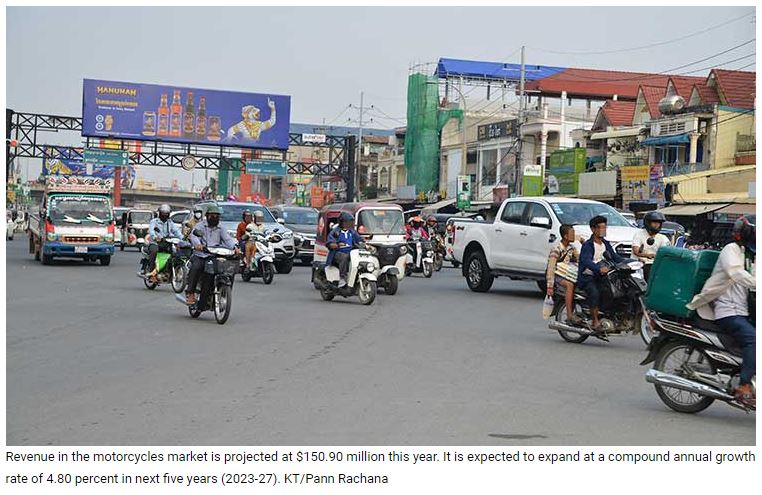Motorbike parts segment to be developed in Cambodia
With the two-wheeler segment of the automotive sector logging rapid growth in Cambodia in recent years, the government has decided to focus on increasing backward linkages for locally assembled motorcycles to increase localisation and create job opportunities.
Revenue in the motorcycles market is projected to be $150.90 million this year and is expected to expand at a compound annual growth rate (CAGR) of 4.80 percent in the five years (2023-27) to reach the estimated market volume of $182 million by 2027, according to statista.com data.
The ‘on-road motorcycles’, the market’s largest segment, in Cambodia is expected to have a projected market volume of $100.90 million this year.
Unlike more developed countries in the region, where rising income levels are causing consumers to shift away from motorcycles, they remain a highly attractive transport option at current income levels in Cambodia.
Motorbikes are used for diverse purposes in Cambodia – from commuting to markets, workplaces and educational institutions, to pulling Tuktuk and vending carts, among others.
A large number of motorcycles sold in Cambodia are assembled within the country by several companies. More than 300,000 motorcycles were assembled in 2019 in the country by large automobile companies like Honda and Suzuki.
This assembly activity feeds high local demand (540,000 new motorcycle registrations in 2019), which is expected to continue rising to an estimated 1.1 million new motorcycle sales by 2030, according to Cambodia’s Automotive and Electronics Sectors Development Roadmap.
Locally assembled vehicles account for more than 80 percent of domestic two-wheeler demand in the country. However, these motorbike assembling companies source the majority of component parts from outside the country.
Local components make up only about a quarter of the total value of two-wheelers assembled in Cambodia, compared to over 80 percent for other countries in the region, according to the government-approved roadmap for the development of the automotive and electronics sectors in the country.
At present, the local component supplier ecosystem for two-wheelers in Cambodia is nascent, and poorly integrated with the vehicle assemblers. Two-wheeler assemblers and Tier 1 component suppliers have also raised concerns about the quality of components produced by local firms, says the roadmap.
Thus, there is a need to strengthen the local component supplier ecosystem for two-wheelers, to increase the share of local content and domestic benefits as well as to prevent economic leakages, it says.
This throws open an opportunity for the country to increase local content and strengthen its role in the two-wheeler assembly value chain, by improving the quality of the local supplier base.
It will allow Cambodia to capture value added in two-wheelers through three main drivers.
First, the overall demand for two-wheelers will increase at a CAGR of approximately 7 percent through 2025. Second is an increase in the percentage of locally assembled two-wheelers. Cambodia currently makes 82 percent of the two-wheelers sold in the country and aims to increase this to 95 percent by 2025. The third is an increase in the share of local content, from the current 26 percent to a target of 85 percent by 2025, comparable to other countries in the region, according to the roadmap.
Rapid economic development, improved income, population growth, and rising rates of urbanization have contributed to the high demand for vehicle ownership in Cambodia. This demand is forecasted to increase as the economy continues to grow.
Given the youthful profile of the population and steady economic growth, the Association of South East Asian Nations (ASEAN) motorcycle industry accounts for around one-quarter (25 percent) of the global industry.
Source: https://www.khmertimeskh.com/501231190/motorbike-parts-segment-to-be-developed-in-cambodia/


 Thailand
Thailand




